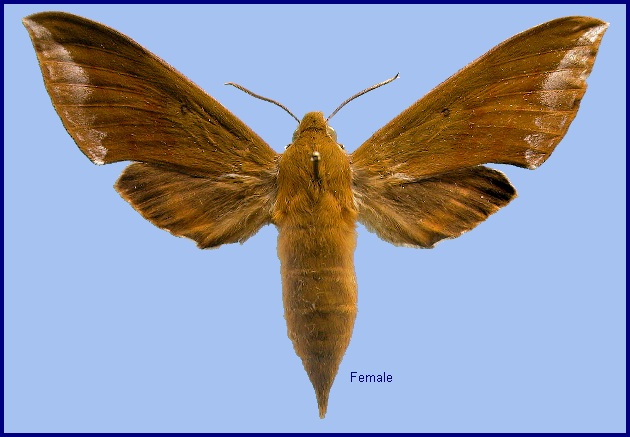
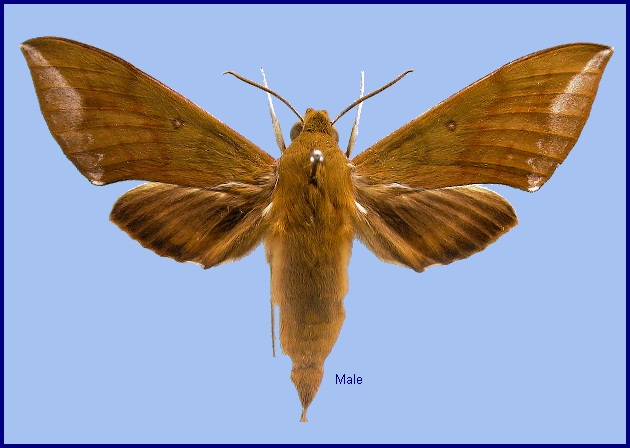
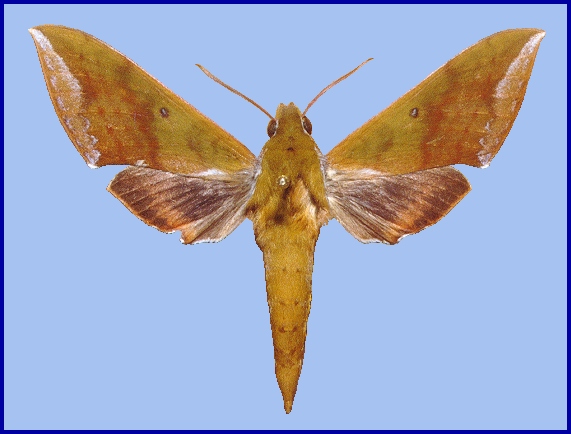
Pergesa olivacea Moore, 1872, Proc. zool. Soc. Lond. 1872: 567. Type locality: Northwest Himalayas [India, Himachal Pradesh,] Simla, 7000 feet.
Synonyms. Pergesa olivacea Moore, 1872.
Wingspan: 72--92mm. Head, body and forewing of a peculiar and characteristic greenish-yellow/olive green colour. Forewing pattern similar to that in Rhagastis acuta. With a round black stigma; a shuttle-shaped marginal area with a waved edge bordered irregularly with bluish-white scales, most strongly at the apex and tornus; narrow and indistinct discal lines reddish-tawny. Antemedian lines obscure, olivaceous; an ochre patch near the discal spot (the black stigma); subbasal area marked with three brown curved lines, and middle area with three ochre zigzag dotted bands. Hindwing smoky-black; a diffuse ferruginous submarginal band. Underside orange-ochraceous, the three discal lines distinct on both wings, except the second, which is often barely vestigial. Abdomen upper side olive-green; lateral side with yellow hair; underside yellowish-white.
Male genitalia similar to that of Rhagastis jordani. Uncus and gnathos sharper. Sacculus slightly longer and tortuous, curving upward apically into the harpe. Phallus longer and straight, anterior lobe of the process ends in a thick transverse hook, and the narrow side is sharper than in Rhagastis jordani (Jiang et al., 2024).
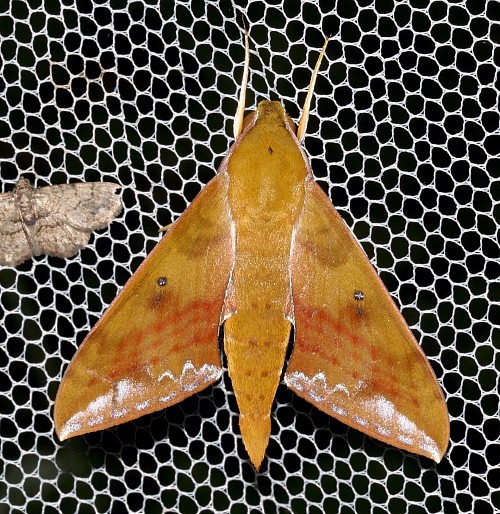
A lachryphagous (tear-drinking) species in northern Thailand.
China: iv (Guangdong); v (Yunnan); vi (Xizang/Tibet); vii (Guangxi); viii (Fujian; Xizang/Tibet).
OVUM: Pale green. Eggs and larvae may be found from May to October in India, and there are probably several broods in the season (Bell & Scott, 1937).
LARVA: Full-fed 90mm, width 14mm, horn 8 mm. According to Bell & Scott (1937), in the first instar pale yellowish-green, with a long, straight black horn. In the second instar, head and segments 2 to 4 green; rest of body green dotted with white and with a pale dorso-lateral stripe on 2 to 4. There is an eye-spot on 5, which is blue edged with yellow; seven pale oblique lateral stripes; and a straight horn with reddish base and tip black. In the third instar a narrow dark dorsal stripe appears; the eye-spot has a pupil which is blue in front, green dotted with white behind, the whole edged narrowly with white in front, yellow behind. The oblique lateral stripes are white, the horn orange. In the fourth instar there is little change, but the oblique lateral stripes become bluish.
In the fifth and final instar, shape as in others of the genus, segment 5 considerably swollen. Head moderately shiny and smooth. Body dull and smooth; horn of medium length, stout at base, tapering gently and evenly to a blunt point, gently downcurved; surface dull and covered with small tubercles (Bell & Scott, 1937).
The green form has a bright grass-green head and body, the body with short, dark green longitudinal stripes across the secondary rings; these are more numerous on segments 6 to 11 than on the remaining segments. A narrow, dark green dorsal stripe runs from 2 to base of horn, broken in the middle of each segment. There is a white dorso-lateral stripe from 2 to the middle of 4, formed of coalescing white dots increasing in size backwards. A large irregular-rounded eye-spot is present on 5, encroaching on to 4, the large pupil deep blue in front, sap-green behind, the green part bearing some large white dots, the pupil edged broadly with pale ochreous above, pale blue in front and white behind, the whole edged very narrowly with black. There are oblique lateral stripes on 5 to 10, that on 5 formed of a series of round white spots, one on each of the last three secondary rings and extending on to the first two rings of 7, the first very small, others in size backwards. The stripes on 6 to 9 broad, white, on the last secondary ring of each segment broken by a transverse green line into a transverse, oval spot, and extending as smaller white spots edged with dark green on to the anterior two or three rings of the segment behind. The strip on 10 running across 11 and 12 to base of horn, white edged above and below with dark green. Horn reddish-brown or purplish, the tubercles brown; legs red. Spiracles yellow edged with green (Bell & Scott, 1937).
In the dark-coloured form the green colour is replaced by a rich brown, with markings the same as in the green form.
The anterior segments of the larva are strongly retractile; the dorsum becomes suffused with greyish (in the green form) and all the markings darker before pupation. Other habits the same as those of Rhagastis aurifera.
Fellowes Manson (1921), in 'Rare and little known Sphingidae' (J. Bombay Nat. Hist. Soc. 27: 753), describes a larva and pupa which he states to be those of Rhagastis olivacea, but his description of the larva agrees with that of Rhagastis albomarginatus. He must have confused the two (Bell & Scott, 1937).

PUPA: 55mm, width 10mm. Tongue-case brownish-red; head, thorax and wing-case dark brown in dorsal area, brownish-red with dark brown streaks and lines elsewhere; lines of brown tubercles along veins of wing-case; wing-case separated from abdomen by a soiled whitish line, not so conspicuous as in Rhagastis aurifera. Abdomen yellowish-brown, the sides with numerous short blackish longitudinal lines; spiracles black, those on 6 and 7 lying on small black patches round which the line dividing wing-case from abdomen runs; the others lying on small whitish patches; cremaster dark brown (Bell & Scott, 1937).
Very similar to that of Rhagastis aurifera in shape and texture. Tongue-case radially striate. Cremaster triangular, tip with two sharply pointed polished shafts, each with a short spine near its base; upper surface rugose, lower deeply grooved.

Larval hostplants. Impatiens in India (Bell & Scott, 1937); occasionally Vitis.
Unknown.
China: Zhejiang; Hubei (Lichuan, 950m); Chongqing (Simian Mountain National Scenic Resort); Sichuan; Yunnan (??Bahand; Kunming; Changning Co., Songzhishanding, 2800m; Gaoligong Shan; Dulongjiang, 1980m; Yingjiang, 1007m); Xizang/Tibet (Motuo/Metok/Mędog/Pemako, 2115m; Mutu, Namjagbarwa region, 850m (Wang, 1988); Zhangmu, 2200m; Nyalam, 2250m; Gamtog); Guizhou (Jiangkou; Shiqian); Hunan (Shangzhi, 1440m); Jiangxi (Fuzhou); Fujian (Guangze, 1200m; Longqi Shan); Guangdong (??Teaberg; Lianping; Guangzhou; Wanzishan, Deqing; Shaoguan; Chebaling, 1060m; Nanling); Guangxi (Dayao Shan, 1120m); Hainan.
From northeastern Pakistan (Rafi et al., 2014; Haxaire, Gujjar & Saeed, 2017), through northern India, Nepal, Bhutan (Irungbam & Irungbam, 2019), Myanmar/Burma, northern Thailand, Laos and northern/central Vietnam (Le & Vu, 2024), to southern China.
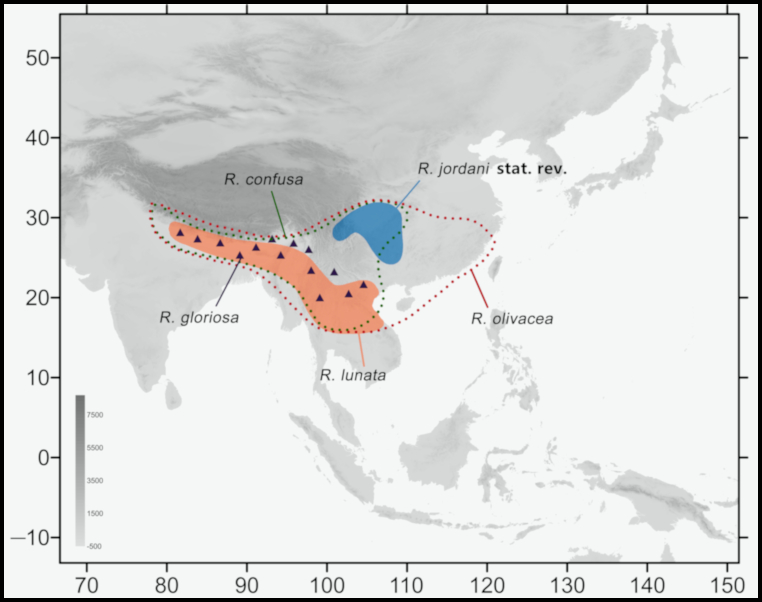
Map: Distribution of species of the olivacea group of the genus Rhagastis. The green dotted line indicates the range of R. confusa, the red dotted line indicates the range of R. olivacea, the blue patch indicates the range of R. jordani, the orange patch indicates the range of R. lunata, and purple triangles indicate the range of R. gloriosa. (© Jiang, Wang, Xu, Kitching, Huang, Hu & Xiao, 2024).
 Return to Sphingidae of the Eastern Palaearctic species list
Return to Sphingidae of the Eastern Palaearctic species list